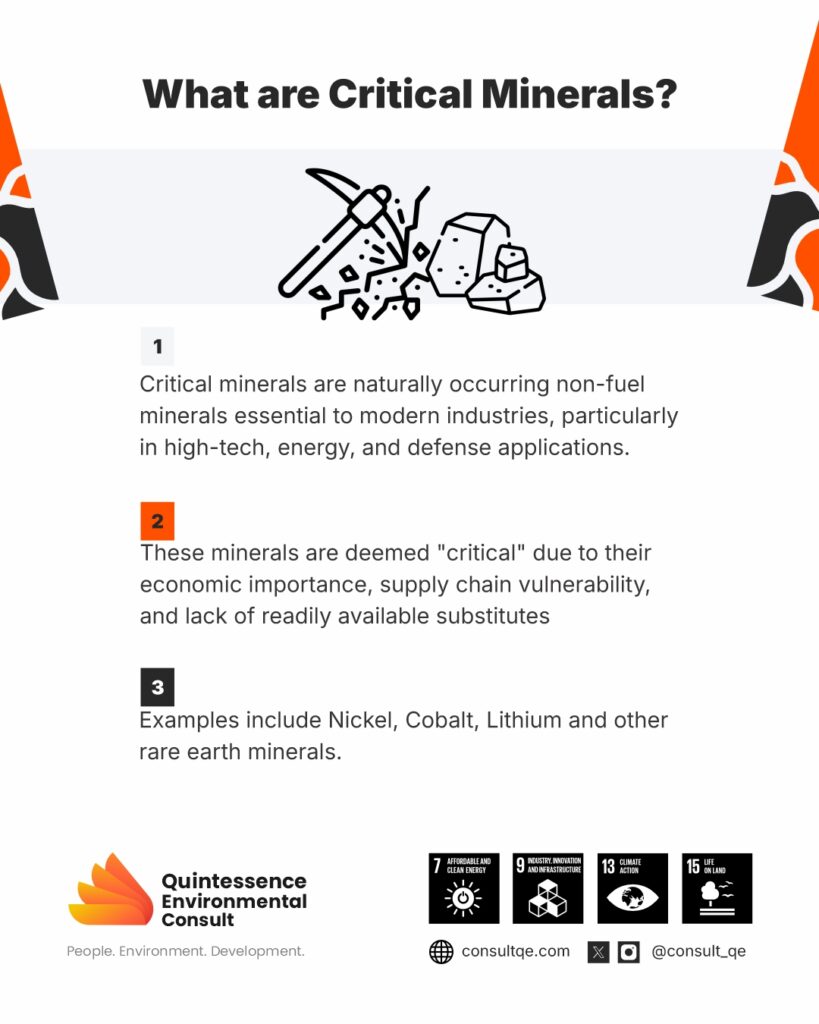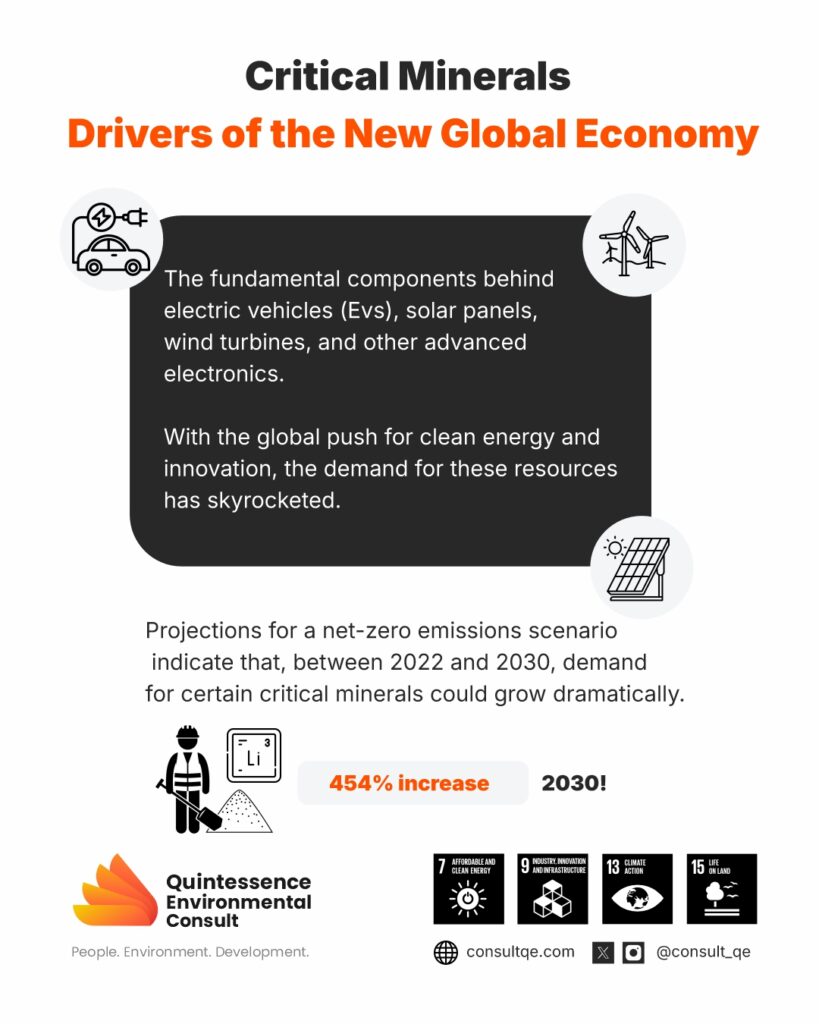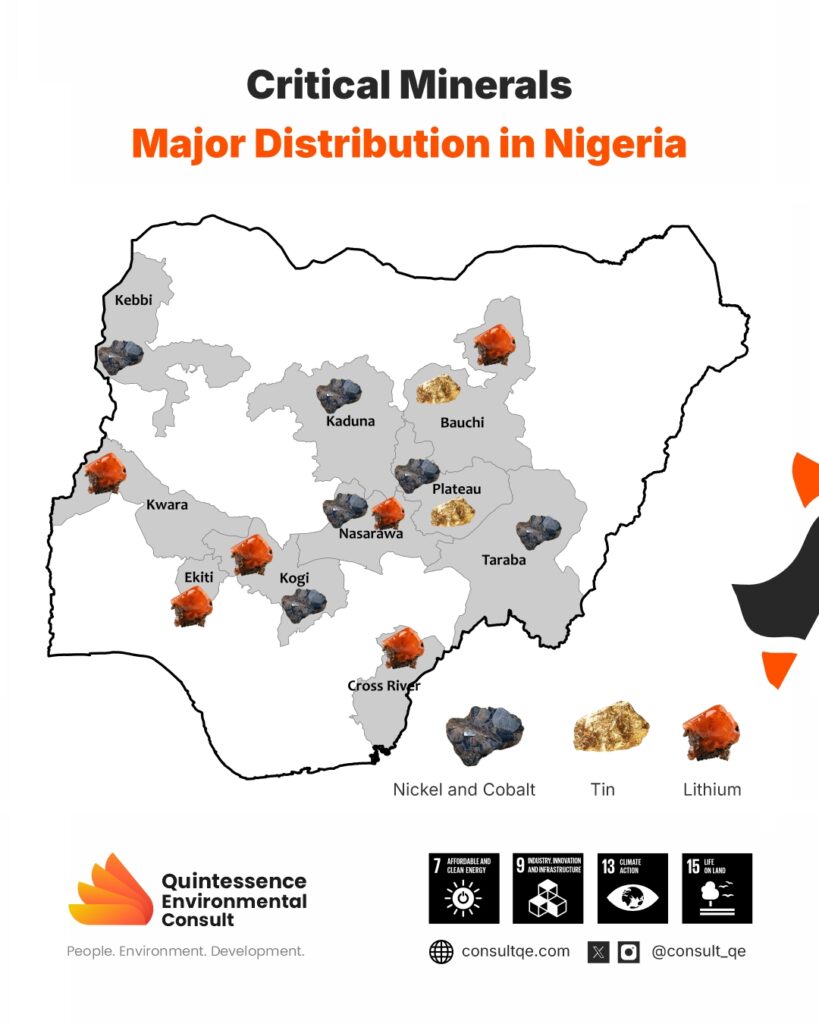Key Takeaways
- Critical Minerals: Drivers of the New Global Economy
Critical minerals are the fundamental components behind electric vehicles (EVs), solar panels, wind turbines, and other advanced electronics. With the global push for clean energy and innovation, the demand for these resources has skyrocketed.
- The Global Race Is On, Can Nigeria catch up?
Countries such as the Democratic Republic of Congo, Chile and Indonesia are already dominating the critical minerals market. Although Nigeria possesses significant resources, it is still playing catch-up. Tin & Tantalum in Jos, Riruwai, Kogo, and other younger granite complexes have been mined since the 9th century.
3. Unlocking Nigeria’s Mineral Potential
The airborne geophysical survey initiated in 2005 collected data in magnetic, radiometric, gravity, and electromagnetic domains for about 44% of Nigeria in 2006 and 55% completion in 2010 should be reviewed and given national priority.
- The Big Problem
Nigeria’s critical minerals sector faces three major challenges: weak policies leading to missed opportunities, unregulated mining causing severe environmental damage, and a lack of local processing capacity, resulting in raw material exports instead of value addition.
- The Game Plan: How Nigeria Can Win
- Make Mining Laws Stronger: Regulations should encourage responsible mining, local processing, and transparency (no more illegal deals).
- Go Green: Mining shouldn’t destroy the land; eco-friendly techniques, land restoration, and community-driven projects should be a must.
- Invest in Mining Technology & Infrastructure: Nigeria needs processing plants, better transport networks, and modern mining tools to compete globally.

Introduction
Critical minerals are naturally occurring non-fuel minerals or materials essential to modern industries, particularly in high-tech, energy, and defense applications. These minerals are deemed “critical” due to their economic importance, supply chain vulnerability, and lack of readily available substitutes. In recent times, we have witnessed critical and rare earth minerals form integral parts of peace negotiations in the Russia-Ukraine war as well as the American Foreign Policy.
In today’s global energy transition, minerals such as lithium, cobalt, nickel, and rare earth elements such as are indispensable for producing clean energy technologies, including solar panels, wind turbines, rechargeable batteries for electric vehicles (EVs), and grid storage systems. Developing countries hold large reserves of these minerals; for instance, African countries account for about 25 % of global reserves, including 19% of those needed for EVs.
Global Demand and the Role of Developing Nations in the Global Supply Chain
The global demand for critical minerals has surged due to their essential role in modern industries, clean energy technologies, and advanced manufacturing. These minerals are crucial for economic growth, technological advancement, and national security. For example;
- Clean Energy Transition: Minerals like lithium, cobalt, nickel, and rare earth elements (REEs) are vital for manufacturing batteries, solar panels, wind turbines, and electric vehicles (EVs). The global drive toward net-zero carbon emissions has further intensified the demand.
- Technological Advancements: Electronics, semiconductors, telecommunications, and defense systems rely on critical minerals such as tantalum, gallium, and neodymium for microchips, magnets, and advanced optics components.
- Industrial Growth & Infrastructure Development: The construction, automotive, and aerospace industries need materials like copper, aluminum, and titanium for wiring, machinery, and transportation.
- Geopolitical Considerations & Supply Chain Security: Many critical minerals are concentrated in specific regions, making supply chains vulnerable to geopolitical tensions, trade restrictions, and resource nationalism.
- Defense & Aerospace Applications: Minerals like tungsten, vanadium, and rare earths are essential for military equipment, jet engines, and missile systems, making them strategic assets for national security.
This growing dependence on critical minerals has led countries and companies to secure their supply chains, invest in mineral exploration, and develop recycling technologies to meet demand sustainably. Developing nations are increasingly becoming key suppliers of essential minerals to the global market.
For instance, the Democratic Republic of Congo contributes approximately 68% of the world’s cobalt imports, Chile plays a significant role in lithium exports, and Indonesia accounts for nearly 48% of global nickel exports. Since 2010, the demand for minerals per unit of energy generated has surged by 50%, largely due to the rising adoption of renewable energy sources. Projections for a net-zero emissions scenario indicate that, between 2022 and 2030, demand for certain critical minerals could grow dramatically—with cobalt up by 115% and lithium by an astonishing 454%.In response to the rising demand, a significant number of critical mineral projects were initiated in 2021 and 2022, marking a substantial increase in global efforts to secure mineral supply chains. (UN Trade and Development).
The specific type and quantity of critical minerals required for the energy transition depend on their intended applications. Lithium, cobalt, and graphite, for example, are essential components of lithium-ion batteries used in electric vehicles (EVs). Prior to their use in advanced technologies, these minerals undergo processing and refining to enhance their purity, improve performance characteristics, and optimize their suitability for various applications. Compared to their raw forms, refined materials hold significantly higher economic value, offering mineral-producing developing nations opportunities to foster downstream industries and stimulate economic growth (UN Trade and Development).

The New Gold Rush: Nigeria’s Untapped Treasure
While Nigeria is not yet a major global supplier, its subsoil conceals a treasure trove of critical minerals such as lithium, cobalt, nickel, and rare earth elements- resources that power everything from electric vehicles to smartphones and solar panels distributed across different states. These resources are the backbone of the global energy transition, and countries worldwide are prompted to secure their supplies. Some of the key critical minerals found in Nigeria include:
- Lithium: Geological surveys have identified lithium-rich sites in Nasarawa, Kogi, Kwara, Ekiti, Cross River, and Bauchi.
- Nickel and Cobalt: In 2015, an Australian firm discovered a significant volume of high-grade nickel deposits in parts of Kaduna, Kogi, and Plateau. Nigeria is estimated to possess five million metric tonnes of Nickel and one of Africa’s largest reserves of cobalt. According to the Nigerian Geological Survey Agency (NGSA), the majority of Nigeria’s nickel reserves are located in Kaduna, Kebbi, Nasarawa, and Taraba.
- Rare Earth Elements (REEs): The key REEs found in Nigeria include Neodymium (Nd) (used in high – strength magnetics and various electronic applications), Cerium (Ce) (used in catalyst and glass manufacturing), Lanthanum (La) ( used in carbon arc lights, flints for lighters applications), Praseodymium (Pr) (used in magnet and glass application), Yttrium (Y) (used in phosphorus production,c, LED’s and display technologies. These REEs are often associated with mineral deposits such as bastnasite, monazite, and xenotime, which can be found in various geological formations across the country, particularly in the Central and Northern regions of Nigeria.
- Tin and Tantalum: Tin has been mined and used in Nigeria as early as the 9th century, with exquisite bronze artifacts from three sites in the Igbo-Ukwu area of Anambra State. As of 2010, the estimated tin (cassiterite) reserve of Nigeria is at least 300,000 tonnes, with a substantial additional quantity buried beneath basalts and volcanic formations in the Jos Plateau. The overall tin resource is estimated to be at least double the amount of reserve with notable fields found in Jos-Bukuru, Riruwai, Kogo, Tibchi, and Dutsen wai, etc.
With the increasing global demand for these minerals, Nigeria has an opportunity to develop its mining sector responsibly and sustainably, potentially emerging as a key player in the global supply chain, provided it develops the right policies and infrastructure. However, inadequate policies, weak enforcement, and unsustainable mining practices threaten to hinder its progress.
Unlocking Nigeria’s Mineral Potential: Mapping, Value Addition, and Sustainability
1. The Need for High-Level Geological Mapping
Nigeria cannot fully harness its critical mineral wealth without first understanding the scale and distribution of its resources. While historical exploration efforts have identified key deposits, a comprehensive high-resolution geological mapping program is urgently needed. It is noteworthy to mention the airborne geophysical survey operations carried out between 2005 and 2007 which mapped Block A, B and C, covering about 44% of Nigeria’s landmass. The survey collected data in magnetic, radiometric, gravity, and electromagnetic domains, mostly flown at a line spacing of 500 meters and a mean terrain clearance of 80 meters
However the survey faced some setbacks until 2010 when the remaining 55% of the survey was completed owing to support from the World Bank. These data need to be revisited and given national priority to validate them and develop strategic exploration plans. was never completed.
2. Expanding the Mineral Value Chain
Beyond exploration, Nigeria must expand its mineral value chain to maximize economic benefits. Instead of merely extracting and exporting raw minerals, the country should prioritize local processing and refining. Establishing domestic lithium-ion battery plants, rare earth element separation facilities, and advanced metal refining industries would not only generate jobs but also strengthen Nigeria’s position in the global supply chain. Strategic partnerships with technology firms and industrial players will be crucial in achieving this transformation.
3. Ensuring Sustainability and Responsible Mining
Once Nigeria secures a clearer understanding of its mineral wealth and establishes a strong value-addition framework, sustainability considerations should follow. Responsible mining practices, environmental safeguards, and community engagement must be integrated into the sector’s long-term development. This ensures that economic growth does not come at the cost of environmental degradation or social displacement.

Conclusion
Critical minerals are undeniably vital for modern society, enabling technological advancements and economic growth. However, their extraction and processing present significant environmental and social challenges. These challenges include water depletion, habitat destruction, pollution, greenhouse gas emissions, displacement of communities, human rights abuses, and exacerbation of social inequalities. It is crucial to acknowledge that the environmental damage from mining can disproportionately impact vulnerable populations and contribute to social class solidification.
Nevertheless, Nigeria cannot afford to remain on the sidelines as the world transitions to a mineral-driven future. This is an opportunity to transform the nation’s economy, but it must be done responsibly. If executed correctly, critical minerals could be Nigeria’s next big success story. Conversely, failure to act could result in environmental degradation and lost potential. It’s time for policymakers, industry leaders, and environmentalists to come together and make informed decisions before it is too late.
References
Gyang JD, Nanle N, Chollom SG. (2010). An overview of mineral resources development in Nigeria: Problems and prospects. Continental Jour. Sust. Dev. 1: 23-31.
Kampunzu AB, Lubala RT. (1991). Magmatism in extensional structural settings – the Phanerozoic African plate. Springer-Verlag Berlin Heidelberg, 637.
Malomo S. (2007). Nigeria mineral resources. Paper presented at the International Workshop on Sustainable Development of Nigeria’s Mineral Potentials.
Obaje N. (2009). Geology and mineral resources of Nigeria. Springer.
Reuters. (2016). Nigeria to tap mineral wealth for economic development.
External Links
https://unctad.org/publication/technical-note-critical-minerals
https://www.dw.com/en/nigeria-taps-into-the-global-lithium-market/a-67135006
https://blogs.lse.ac.uk/africaatlse/2024/10/23/nigeria-can-unleash-a-mineral-boom-if-it-gets-the-governance-right/#:~:text=The%20country%20reportedly
%20has%20an,the%20failures%20of%20the%20past.
https://www.sun.edu.ng/knowledgebase-articles/overview-of-the-occurrence-of-nickel-in-nigeria/
https://guardian.ng/opinion/maximising-nigerias-rare-earth-elements-potential/



Very insightful. These minerals can transform our nation and attract investment.